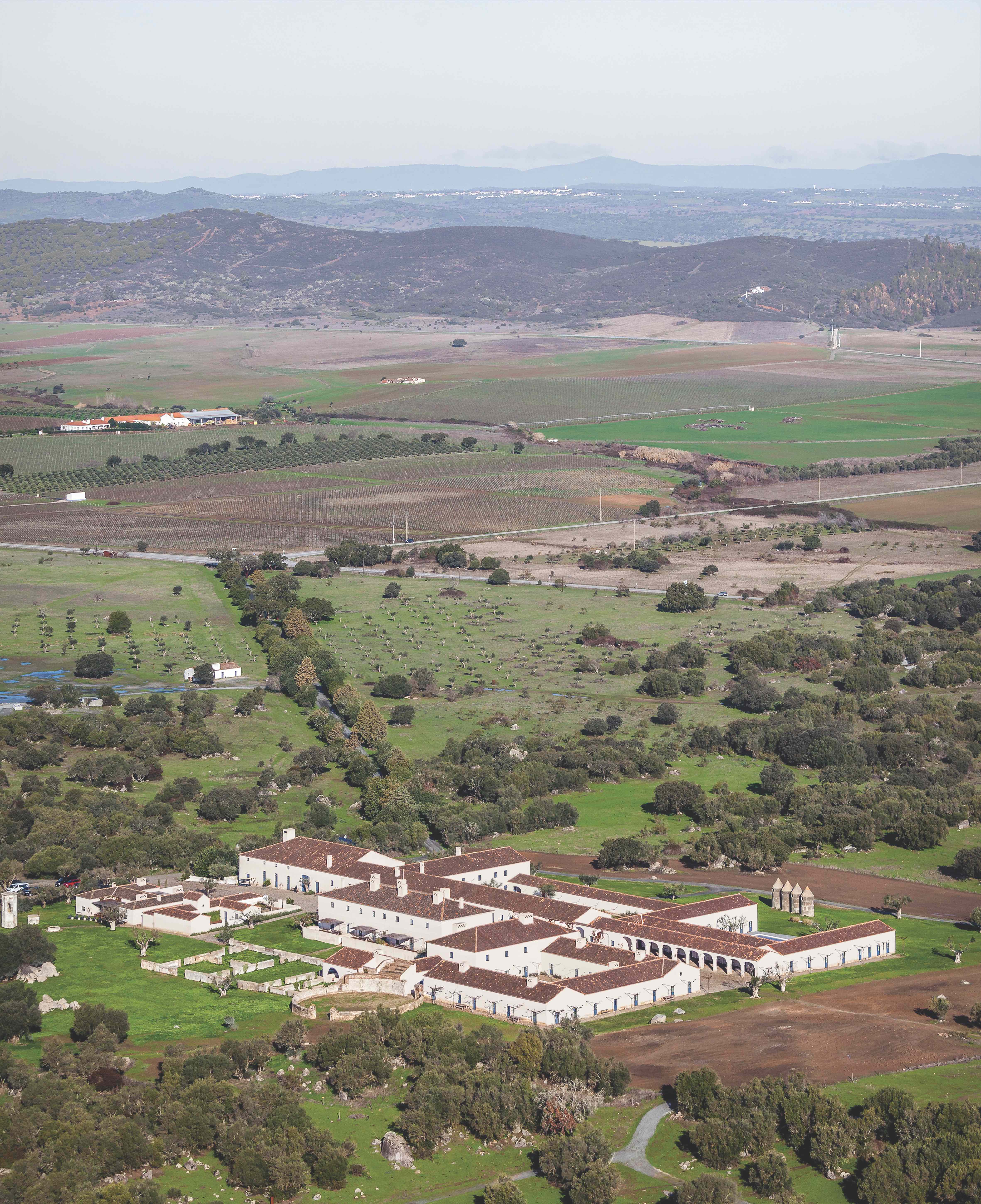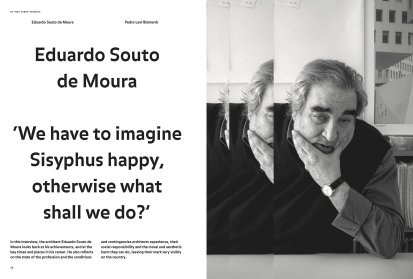Souto de Moura belongs to that loose group of architects, with its centre of gravity in Álvaro Siza, generally called the ‘Porto School’. His affiliation with modernism and his choice of Mies Van der Rohe as his main point of reference are fundamental features of his vast architectural output. In conversation, he betrays both a disenchantment and a lively enthusiasm for architecture as an art and profession. His pragmatism goes hand in hand with his vision in which the ideal of modern architecture, the happy combination of form and function, is always on the horizon. But Souto de Moura is also an architect very aware that architecture is, to the highest degree, a ‘social’ gesture, and that the architect is vested with a responsibility he is duty bound not to set aside. These and other questions run through this interview and are addressed with great lucidity.
In this interview, the architect Eduardo Souto de Moura looks back at his achievements, and at the key times and places in his career. He also reflects on the state of the profession and the conditions and contingencies architects experience, their social responsibility and the moral and aesthetic harm they can do, leaving their mark very visibly on the country.
PEDRO LEVI BISMARCK Looking back on your career, we can see that it runs alongside the history of democracy in Portugal: in São Vítor, with Álvaro Siza – what was then called the PREC, or Ongoing Revolutionary Process and the desire ‘to design a new country’; in the house in Gerês and the market in Braga – your early experiments; in Foz and Nevogilde – houses for a progressive bourgeoisie; then, the leap to designing public buildings – facilities for the welfare state; and lastly, a resetting of the compass with the economic crisis of 2008-‑2014 – bringing international projects, and also hotel conversion projects as Portugal strategically redefined itself as a tourist destination. From promise, through to consolidation and crisis, how do you see your career over this historic process?
EDUARDO SOUTO DE MOURA Architecture has to move with the times, it needs power and, fundamentally, money: it is always dependent on circumstances. My first opportunity to work in architecture was with Siza, on housing association work for SAAL1, where I contributed significantly to those three houses in São Vítor. We practically lived on the spot. It was exciting for a young student: both the architecture, and the transformation of a new country. And that partly explains why I signed up to the modernist movement. There was a certain thirst for modernity – using pilotis was almost a manifesto and Corbusier’s Five Points were a kind of left-wing textbook. So there was this dream of building a new country on a micro-geographical scale which was SAAL. But that was followed by great disillusionment, politically, not with SAAL as such. When I saw that the houses were going to the association’s leaders, I suffered my first political shock from the left. Later, in the early eighties, a whole new and fresh middle class emerged, looking for houses. I started doing this sort of building and I needed a supporting language.
PLB Precisely: an example that I find interesting is your reflection on the use of a ‘Miesian’ wall in granite, not as a mere formal element, but as a device that would make it possible to conciliate the ‘promise’ of modern design and the real conditions in which architecture was produced in Portugal in the 1980s.
ESDM I believed in what the modern movement wanted. Portugal needed fifty hospitals to be built, half a million houses. But at the same time, there was all that post-modernist euphoria in Europe and in Lisbon. In my view, the tool we needed to build those half a million houses was the modern movement, and not pediments and columns. There wasn’t the money for it. Within the modern movement it was Mies that interested me, because he was the most technically minded: he invented a system of building. That was something that had to be done in Portugal. But we couldn’t use cement, or iron, because either we didn’t have it or it was too expensive. I worked with stone not out of any sympathy for the vernacular, but because the building contractor for the Braga market put me straight: ‘There’s no money for concrete, if you like, we can do it in stone, we’ve no shortage of stone.’ So I started working with stone for a pragmatic reason: it was cheaper. But at the same time, it seemed to make sense to make use of architectural fakery, which was all the rage at the time. And so I started to work with simulations, using the representation of the materials and the walls. And that abstract architecture made just out of walls – in essence, a neoplastic support – provided me with a certain method for architectural design. Then there were technical constraints and it was a bloodbath of extremely expensive and entirely fake details. Well, architecture is all dissimulation. This was not what repelled me ethically, but it started to be something contra natura, stripped of that initial pragmatism.
"An architect is an opportunist: he has to seize opportunities, classify them, judge them, analyse them. Architects have to understand reality. Reality has changed and I have changed over time."

Burgo tower, Porto, 2007 © Photo: Luís Ferreira Alves

São Lourenço do Barrocal, Monsaraz, 2016 © Photo: Filipe Jorge
PLB At the same time we start to see projects on another scale.
ESDM Precisely. With the Burgo Tower [1991] I went from one to twenty-three storeys. I’d never done a lift. And it was necessary to find another theme. It was then that I met [Jacques] Herzog. We were both teaching at Harvard. He had already gone through all those phases and had his finger on the cultural pulse. I had to design a tower, but it couldn’t be a neoclassical tower. And so I thought: ‘We’re living in the age when mechanics and technology rule supreme, and so it makes sense to do something along the lines of Herzog and the conversations I had with him, what he called mechanistic accumulation.’ That’s how I designed that overlapping set of pieces that together made up the Burgo Tower. I will always make sure the architecture offers a concrete response to a problem in particular circumstances. There’s no choice but to go along with the conditions in which architecture is produced. In this sense, an architect is an opportunist: he has to seize opportunities, classify them, judge them, analyse them. Architects have to understand reality. Reality has changed and I have changed over time.
PLB Running through your early work, there seems to be an inner dialectic that expresses itself in the frequent use of irony, ruins or fragments. But in your recent work, such as at Herdade de São Lourenço do Barrocal [2010-2018], some of these principles appear to be in retreat. At the Pousada de Santa Maria do Bouro [1989-1997], for example, the ruins have nothing romantic about them, they accept the presence of the architectural gesture. In contrast, at Barrocal, we see a commitment to remaking everything. We might say: at Bouro, history is revealed in discontinuity as crisis; at Barrocal, it is revealed in continuity as a simulacrum – a little like, to use your words, ‘swallows in Alfama’. There’s no irony, no conflict. My question is: has that dialectic been exhausted – insofar as it belonged to a given historical moment – or have we simply moved on? Is this the result of a change in design strategy or an accommodation with the terms of the commission?
ESDM There is an accommodation, of course. But above all, there’s a degree of reflection on the consequences of the Bouro project. Bouro is a manifesto because it stands in opposition to the methodology of [Fernando] Távora. Restoration always seeks out a specific century. Távora chose the nineteenth century. But I asked myself: ‘Why do I have to choose the nineteenth century? I’m in the twentieth century, I’m going to do it in the twentieth century way!’ And so I don’t actually have to reinstate a century. I have to make a building with the stones at my disposal. ‘Bouro is a new building made with old stones’, is how the design specifications start. But the downside was that this became fashionable. And I started to see lots of buildings being decapitated – pretending to be modern – where the roofs were taken off. I didn’t want to be modern, I wanted to keep the ruin. And I later regretted what I had set in motion. I eventually understood that heritage is not an object, it’s a geography, an environment, an atmosphere. And that was precisely what I liked when I arrived in the Barrocal: an environment. I read up about the Barrocal region, including José Cutileiro’s thesis [Rich and Poor in the Alentejo], which is precisely the history of the Barrocal. At the time I thought: ‘I can’t rebuild this because there are no bakeries, no ironsmiths, no poverty; but the buildings fit into the landscape in a way that won’t change.’ But how do you build an environment? It’s like in the theatre, you design the sets. I made walls in concrete, because everything was falling down. And I wasn’t going to use adobe bricks because they’ll just collapse again. But what I wanted was to understand the texture and the feel of the adobe, and so I created that simulation of concrete clad in adobe, like make-up. Which I felt wasn’t bad. I like it, and the you don’t really notice the architect’s hand. In all this, there’s a consequence – probably because I’m seventy years old – which is that I’ve seen the state the country’s in. And please don’t tell me it’s not the architects...
[...]


Share article